
Artist's conception of PH1 copyright Dirk Terrell 2012
If you just woke up from a deep sleep, Planet Hunters has recently published a science paper titled,
" A Transiting Circumbinary Planet in a Quadruple Star System " named PH1 for Planet Hunters first confirmed planet. A very popular topic. If you search Google and type in key words PH1 and Planet Hunters over 55K hits will show up this week. Not a bad few days work of publicity for this very interesting find. There is something captivating about regular people finding exotic exoplanet systems. Kian Jek and Robert Gagliano are credited for the discovery.

 Robert Gagliano
Robert Gagliano
.
Kepler Science Conference December 2011- Right to Left
Kian Jek, Dr. Frank Drake, Daryll LaCourse,
Dr. Svetlana Berdyugina
Photograph by Thomas Lee Jacobs
Kian and Robert have made other published finds at Planet Hunters such as a planet candidate orbiting KIC 4552729. The uncovering of PH1 that is orbiting KIC 4862625 all began on the Planet Hunters Science Thread:
Finally - an EB with a planet?
Started by
kianjin (Kian Jek)
8 months ago
robert gagliano
8 months ago
kianjin
in response to
robert gagliano
You are right - looking at the raw flux, there appear to be 3 matching dips, at BJD 237.79, 374.5 and 511.11. (subtract 131.511 to get the PH timings). The duration appears to be consistent, ~12 hrs.
8 months ago
kianjin
I removed all the EB primary/secondary eclipses, leaving only this third transit.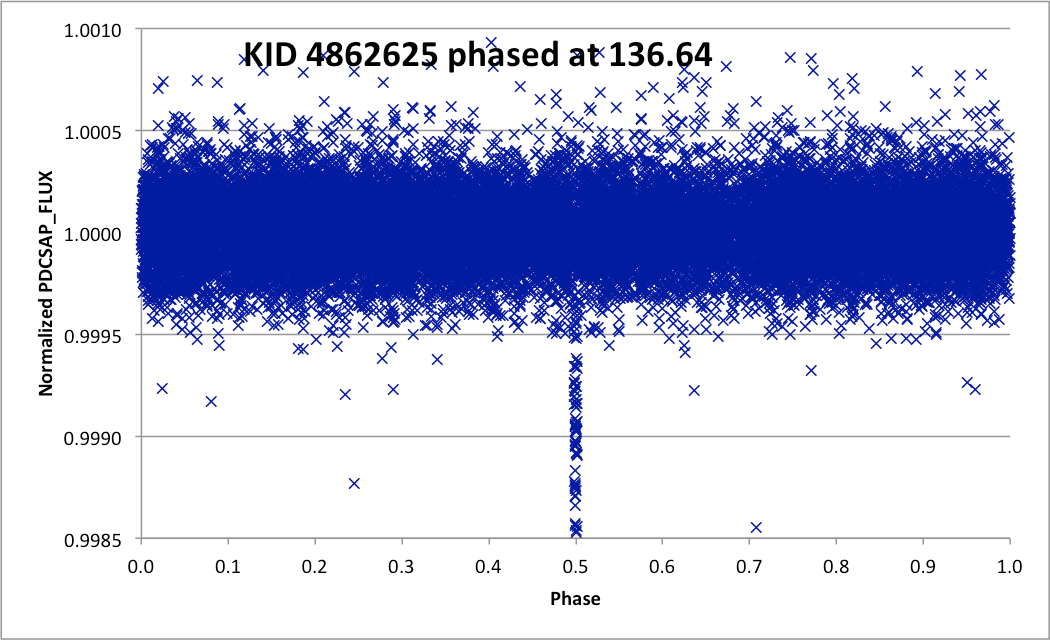

As can be seen, the periodicity is pretty good. However, the stacked transit curve looks a little lop-sided. It could possibly be due to the fact that transit 2 was interrupted by a primary eclipse. Maybe we need to see one or two more transits to be absolutely sure?
Kian posted again on the Discussion page for the suspected candidate where other members chimed in. That's how it works at Planet Hunters, everyone can voice their views.
kianjin (Kian Jek) 8 months ago
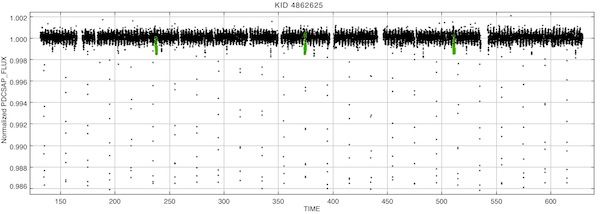
The EB primary/secondary eclipses were removed, leaving only this third transit:
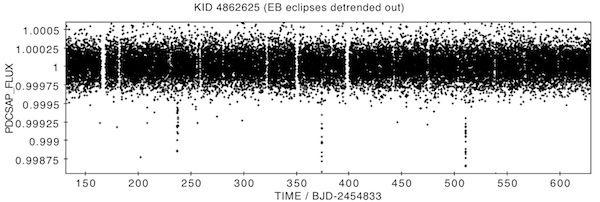
and obtaining this phased curve:


As can be seen, the periodicity is pretty good. However, the stacked transit curve looks a little lop-sided. It could possibly be due to the fact that transit 2 was interrupted by a primary eclipse. Maybe we need to see one or two more transits to be absolutely sure?
The currently measured transit duration of 13.1hr appears to be too long for a central transit of this primary, but it is possible that the planet, a ~3 RE object, based on the transit depth, is in an eccentric orbit.
8 months ago
ajamyajax
'Well done' from a humble PH'er! I will enjoy reading the scientific paper that hopefully follows. :))Some general info for others interested:
http://en.wikipedia.org/wiki/Circumbinary_planet
6 months ago
arvintan
I think there's another possible transit at 381.6-382.2. Just open the image in a new tab.
6 months ago
ajamyajax
in response to
arvintan
arvintan:Took a look and that appears to be the third transit on Kianjin's chart above. Sorry about that.
I think there's another possible transit at 381.6-382.2. Just open the image in a new tab.
6 months ago
arvintan
in response to
ajamyajax
@ajamyajaxAre you sure? Coz I think the deep one in 379 is the third transit in Kian's chart. If you work you're way back from 379 with the 136.64 day period, you'll get the other two. But if you take the one I proposed, you're not gonna get any good hits.
6 months ago
ajamyajax
Ok I'll look again, maybe I'm wrong. Gotta rush off right now
but will chart later. And appreciate your centroid check on the new
multi-EB one. Our trying to 'get it right' seems like good science to
me. :)
6 months ago
ajamyajax
in response to
arvintan
arvintan:Arvintan, now I get it! At least I hope. You mean the area marked with a blue box in the chart below, right? I agree with the similar rounded appearance, this one could be yet another transit. But due to its shallow nature could also be tough to prove without a number of eclipses.. If you see them however, let me know if you need a chart to help establish a period there.
@ajamyajax
Are you sure? Coz I think the deep one in 379 is the third transit in Kian's chart. If you work you're way back from 379 with the 136.64 day period, you'll get the other two. But if you take the one I proposed, you're not gonna get any good hits.

6 months ago
arvintan
@ajamyajaxYes, that's the one. I tried looking for other similar dips but couldn't find one. Should be the case if the planet calc says it's supposed to have a period of somewhere around 872 days for a 2.1 rE planet at 1.725 AU.
And yes, any science with teamwork in it is good science. A pleasure to work with you, sir. :)
6 months ago
JKD
likely an EB with p ~20d having a third object around with p ~136.5d
kianjin 2 days ago
These TTVs are also evidence that this planet was almost certainly bound to the binary and not a BG EB blend. There are more accurate figures published in the paper, but this was what we had back then:
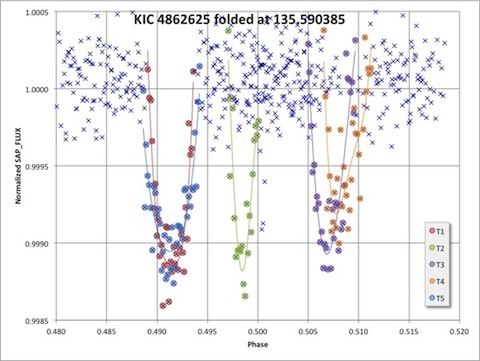
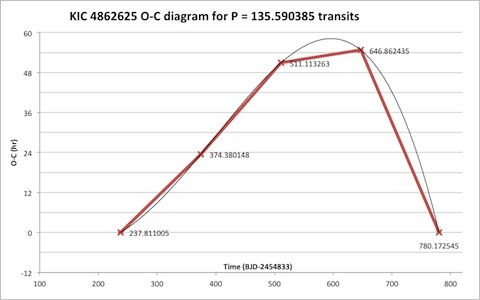
Planet Hunters Offical Blog:

